Effective marketing is arguably the most critical component of any thriving business. It’s what attracts potential customers to your brand, gets your name and products into the wider world, and how you’ll be remembered over time.
And, as with any other important business decision, marketing is not something you should just do. It’s vital to have a detailed marketing plan any time you want to build brand awareness, promote a product, or simply maintain relationships.
But if you’ve never had to create a strategic marketing plan template, knowing where to start can pose a challenge to even the most shrewd business person. From building buyer personas to completing your company SWOT analysis, we’re here to help you learn how to write an effective marketing plan that you can use to improve your digital and content marketing and take your company to the next level.

What is a marketing plan?
Before we get sucked into how to write a marketing plan, it’s worth taking some time to establish a marketing plan definition. After all, if you’re not sure what a marketing plan is, you’re never going to be able to write a great one!
In simple terms, a marketing plan is pretty much what it says on the tin – it’s a plan for what, when, where, why, and how your marketing is going to look over a set time period.
In other words, a marketing plan is like a road map for all your digital marketing efforts. They will contain a timeline, targets, and KPIs to help you figure out precisely how your marketing matches your business mission and specific goals.
Marketing plans are also invaluable for keeping your company on track, with measurable targets to let you see how each campaign is performing.
But while an effective content marketing strategy might be essential, it doesn’t have to be scary. In fact, many sample marketing plans are straightforward word documents containing all the necessary executive summary information and detailed roadmaps.

Types of marketing plans
So, now we know that a marketing plan should act as a road map for where you want your marketing team to take your company; it’s time to dig a little deeper into the types of marketing templates you can create.
There are all sorts of different ways you can design a digital marketing plan, and the right one for you will depend on what you’re hoping to achieve. That said, you’re unlikely to need just one type of plan. The best marketing team will have several sample marketing strategy plans active at any one time.
Some of the most common types of marketing plans include:
- Quarterly or annual plans: These marketing templates are made to highlight any and all strategies or campaigns you intend to undertake in a specific time period.
- Paid marketing plans: These plans are specific to paid marketing strategies. This could include paid-for native advertising, PPC campaigns, or paid social media promotions.
- Social media marketing plan outline: This could overlap with your paid marketing plan, but it’s often worthwhile having a comprehensive social media marketing plan that covers all the channels, tactics, and social media campaigns you intend to run on social media.
- Content marketing strategy: Your content marketing strategy could also cover social media and paid marketing plans but is more likely to cover aspects like blog posts, email marketing, and other content-based marketing you intend to create, along with the aims of each campaign and advertisement.
- New products and services launch: If you plan on releasing new products and services into the market, you’ll need a digital marketing plan to go along with it. This will include an executive summary of your target audience, along with details of the product/service and how you intend to spread awareness.
Keep in mind, none of these should be confused with a content marketing strategy. A marketing strategy is different from a strategic marketing plan.

Marketing plans vs. marketing strategies
So far, we’ve only looked at what a marketing plan is and how it can help your marketing team establish goals and plans of action. However, many people get confused between strategic marketing plans and marketing strategies (understandably).
While a marketing plan is designed to overview the marketing your company plans on undertaking over a set time period, a marketing strategy is more detailed and focuses on the individual campaigns.
In other words, a marketing plan should contain several marketing strategies.
As an example… If your brand plans to release a new product, your marketing plan will cover how you’ll introduce the product to your target market, which distribution channel you’ll use, your tone of voice, and much more.
Within this overarching plan, you’ll also have several content marketing strategies. For example, you will likely have an Instagram campaign strategy to highlight how your new product will be promoted on this specific marketing channel. You might also have an email marketing strategy that incorporates different marketing objectives to the campaign you’re running on Instagram.
You should now be able to determine the difference between a marketing plan (introducing the new product to the market) and a marketing strategy (focusing on the specifics).
What does a marketing plan look like?
There are very few hard-and-fast rules as to what a marketing plan has to look like, and marketing plan examples can be pretty wide-ranging in appearance, from word documents to slide shows and everything in between. You could even create a video.
But although marketing plans can look incredibly different, they will always contain a detailed executive summary covering all the key aspects and marketing objectives.
Most marketing teams produce plans that contain the seven “Ps” of marketing. These were initially the “Four Ps,” but they’ve been expanded on over time to allow businesses to draft more comprehensive plans.

1. Product
Your “product” doesn’t actually have to be a physical product; it’s just whatever you’re looking to promote with your content marketing strategy. You will need to clearly define the “product,” including why it’s important and what effect it will have on potential customers and their lives. You should also include the unique selling proposition (USP) of the “product.”
2. Price
Obviously, the “price” section should include the price you’re charging for the “product” and any promotional discounts applicable. But this should also cover aspects such as profit margins, a marketing budget, supply and demand, and anything else that might affect your pricing strategy. Whether you have a huge budget or are looking for low-cost marketing options, you should be sure to cover this as part of your pricing strategy.
3. Place
Keep in mind that your audience might not be shopping for your “product” when they come across your advertising. Therefore, you need to consider where your target audience spends their time and be sure to focus your marketing efforts on those locations. For many companies, this location will be social media. Email can also be an effective way to get your marketing in the right place at the right time. Use social media marketing statistics and buyer personas to help establish where your target market spends their time online and offline.
4. Promotion
Chances are, this “P” is what your marketing plan is all about… Building brand awareness and/or promoting your products and services to your target audience. This “P” will include elements such as advertising (paid or unpaid), social media marketing, email marketing, SEO, and more. You should also be sure to consider any offline promotional activities (for example, billboards and other IRL advertising) and consider how it all fits into your overall marketing objectives.
5. People
All the other “Ps” are irrelevant if you don’t clearly define the people you’re marketing to. This includes building detailed buyer personas, figuring out touchpoints, and reducing any friction or pain points your target market might be experiencing. “People” can also go further than this and consider your employees and team members. For example, the fifth “P” might cover who is responsible for which distribution channel, who’s writing what blog posts, and more. It could also involve ensuring your teams are treated with respect.
6. Process
The “process” of your marketing plan looks at the how of the task. This should include what research your marketing team still needs to undertake, which distribution channels you’ll be focusing on, the frequency of your posts, etc. It could even include a timeline to success, with measurable SMART goals you can check on throughout your campaigns.
7. Physical evidence
The final “P” is “physical evidence,” which should incorporate all the research you’ve compiled before crafting your marketing plan. This should include any insights into your competitors, a SWOT analysis (which we’ll cover in more detail shortly), information on how you created your buyer personas, and any other relevant “evidence” to support your plan. Effectively, it’s the why of the marketing plan… As in, why should this plan be followed? If any research is missing, you should also include why it’s not been included and where it will be completed in the subset marketing strategies.
How to write a marking plan
Although the seven “Ps” of marketing are vital to your marketing plan template, they don’t quite tell you how to write a marketing plan. For this, we’ll need to go into a bit more detail about the critical aspects of your plan and some of the other things you need to include.

1. Confirm your business mission statement
When drafting your marketing plan, the first thing you should do is write an executive summary about your company mission and overarching goals. You’ll need to have an established mission statement that defines your brand’s core function, purpose, and goals to achieve this.
Once you’ve established your business mission statement, you can use this to lead your marketing missions and ensure every aspect of your brand is on the same page.
While you’re evaluating the business, it’s also a good idea to complete a SWOT analysis. This stands for Strengths, Weaknesses, Opportunities, and Threats that face your business and need to be considered as part of any advertising campaign. It’s always a good idea to complete a SWOT analysis early on in your marketing plan research. This helps you be as unbiased as possible and gives a clearer view of the company’s current situation.
2. Determine the KPIs
Just like a roadmap will include signposts that you can use to track your progress to the final destination, a good marketing plan proposal should also include SMART goals and KPIs that you can use to monitor your progress.
A few examples of marketing plan KPIs might include tracking website visits with organic page views, likes on a social media post, or the number of followers you’re gaining. These are clear, quantitative marks you can use to monitor your progress.
When determining your KPIs and goals, it’s also essential to establish a baseline to compare the business when you started the campaign and how your advertising has helped the company grow and/or reach its targets.
3. Identify your buyer personas.
It’s vital to include a buyer persona, audience persona, or user persona in your marketing plan outline. This effectively takes us back to the fifth “P” and provides detailed information on who your audience is likely to be.
As defined by Hubspot, an audience persona should be “a semi-fictional representation of your ideal customer based on market research and real data about your existing customers… The more detailed you are, the better.”
Personas should include everything you can possibly know about your customer base and target market. You should incorporate demographics including age, location, education, work, where they hang out online, what their media consumption habits are like, what their needs are, their biggest pain points, what they’re passionate about, and more.
You can find this information by researching your target market and current users, then compile it to build a few personas that your marketing team can relate to. You might even find it helpful to add pictures and names to make the personas more realistic.

4. Set your content initiatives and strategies
In this section of your marketing plan outline, you’ll be looking at the main points of your plan to create an executive summary of what, how, and when you’re going to be advertising.
This is also where you’ll figure out what types of content will be covered by the plan and which distribution channels you’ll use to get the word out.
To complete this section, ask yourself the following questions:
- What type of content will you create?
- How much content will you create?
- What are your goals and KPIs for each piece of content?
- What channels will you distribute your content on?
- How will paid advertising be used?
5. Define any aspects that will not be focused on in your plan
In step four, we looked at what your content plan will cover, but it can also be highly beneficial to consider anything excluded from the plan.
For example, in this sample marketing strategy from Venngage, the business clearly defines its mission to provide “inspiration, information, and cultural immersion for runners,” but explicitly excludes “weight-trainers, bodybuilders, powerlifters, and so on” from the mission statement.
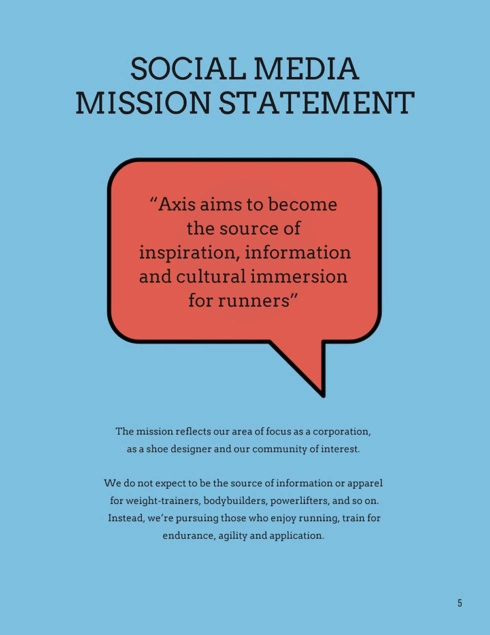
Just like in this example, it’s essential to keep in mind that you can’t please everyone all the time, and it’s okay to specify what the marketing team can leave out.
6. Specify your marketing budget
As with anything, writing a marketing plan also means ensuring your expenses are covered. A pricing strategy is essential as part of any marketing plan proposal, and you must be sure to specify where and how much money can be spent as part of a detailed budget.
This shouldn’t just include a marketing strategy for things like paid-for advertising, however. You can also use this section to cover other costs such as freelancers, sponsorships, or other expenses that may come up throughout your campaign(s).
7. Identify the competition
No situation analysis would be complete without identifying and analyzing your competitors. This research is two-fold:
- Identifying and analyzing your competitors can provide valuable insight into what is working well and what people are interested in.
- It can also highlight the differences between competitors and your company, potentially offering insight into areas you excel in and/or places where you could do better.
Competitor research is also valuable when it comes to search engine optimization. With Google Ads, highly competitive keywords are likely to be more expensive to gain a ranking position, and you may be better off going for a less competitive phrase. Similarly with social media, if a key competitor company is dominating a particular platform or hashtag, you might want to consider varying yours, focusing elsewhere, or boosting your marketing strategy in this area to compete.

It’s worth putting a relatively broad scope onto your competitor research, as your key competitors might not even be in the same industry. We love the quote from the CEO of Netflix explaining, “sleep is our competition.”
8. Outline who’s working on the plan and their responsibilities
Even the clearest, most thorough, and complete marketing plan example is useless if your team doesn’t know who should be working on what. As part of the brainstorming, you should have established a clear idea of who will be working on each project and have individual goals and KPIs to keep everyone on track.
Marketing plan examples
Knowing how to create a marketing plan and some key components that should go into one are only half the battle… You still need to actually compile the information and create a marketing plan proposal that will wow the powers that be.
To give you some inspiration for your next business and marketing plan template, take a look at some of the best sample marketing plan examples we’ve found. These will show you how your proposals could look in the real world and help you see how the various categories relate to one another to create a thorough marketing plan proposal that your company can get behind:
1. Contently content strategy waterfall
Although this is more of a simple marketing plan template than a complete business example, Contently’s content strategy waterfall is frequently considered one of the best marketing campaigns templates out there.
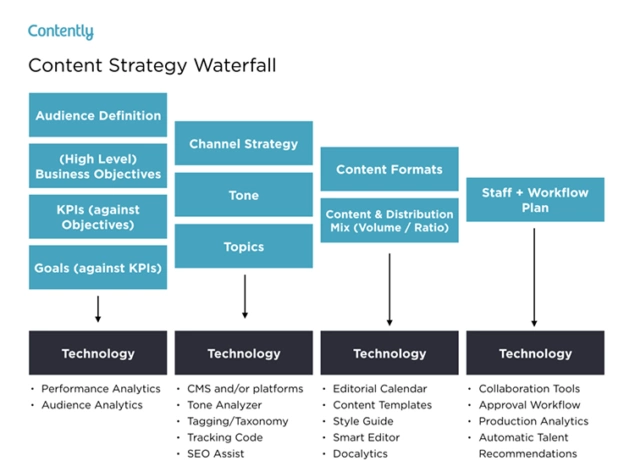
The straightforward design of this one-page marketing plan provides a clear workflow that users can follow, with extra bullet points to expand on the various categories included.
You can use this business and marketing plan template to provide guidance on how to compose your next market plan proposal and ensure you cover all the marketing plan steps necessary to wow.
2. Lush marketing plan
This marketing plan example by Lush provides an excellent illustration of how your company’s mission statement and tone of voice can be used even with internal publications.
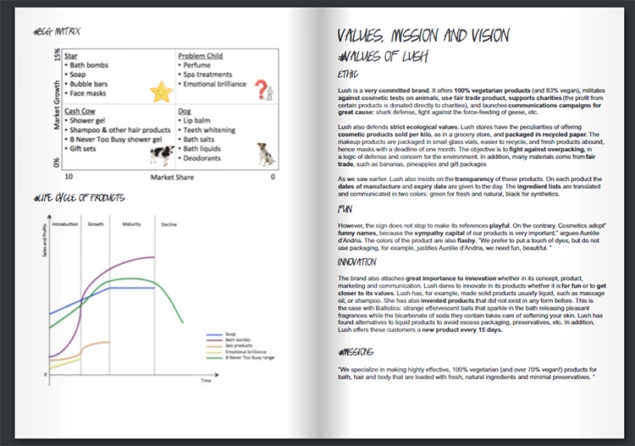
The plan itself is presented as a magazine, and anyone familiar with the brand will instantly recognize the bespoke branding and style of the publication.
In terms of actual content, Lush’s marketing plan contains details on market segmentation, SWOT analysis, packaging, and the overall retail experience customers expect from the brand. It also highlights the brand’s mission statement, vision, and values and how these connect to their customers. There’s virtually nothing missing from this example.
3. Coca-Cola Content 2020 Initiative
This content marketing strategy plan was released by one of the most well-known brands globally, with a huge market share.
The strategic marketing plan the marketing team has produced here a little unusual in that it takes the form of an 18-minute video, but this powerful brand has done a great job of ensuring every second is engaging and relevant, and there’s even a surprise at the end!
The video format for this plan works well as there’s a firm focus on storytelling and creating conversations and provides a valuable insight into the massive world of content marketing that Coca-Cola encompasses. We highly recommend you take a look at this rare treat.
4. Naperville Park District comprehensive marketing plan example
This 79-page digital marketing plan from Naperville Park District is probably the most comprehensive marketing plan example on our list.
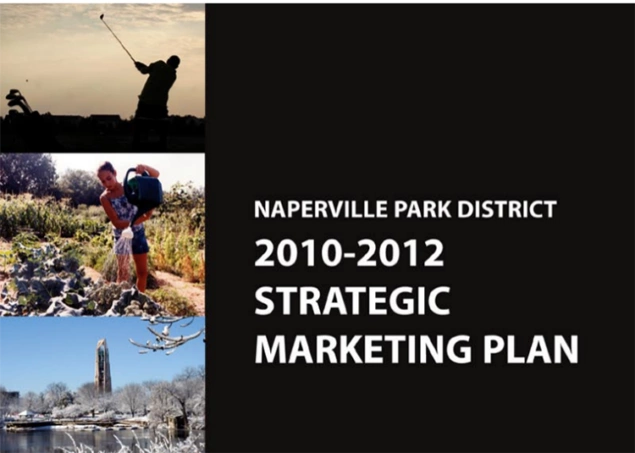
Leaving literally no stone unturned, Naperville has dubbed this plan “a living document,” and has made their intention to continuously update and review the plan over the next five years incredibly clear.
Because the plan spans such a long time, you can expect it to be a comprehensive guide covering everything from the business mission statement to public relations to marketing budget and pricing strategy challenges.
5. Starbucks one-page marketing plan example
Starbucks is known for its consistent branding and strong social media presence, but this one-page marketing plan example from the business is surprisingly concise. However, don’t make the mistake of thinking this short and sweet marketing plan has left anything out…
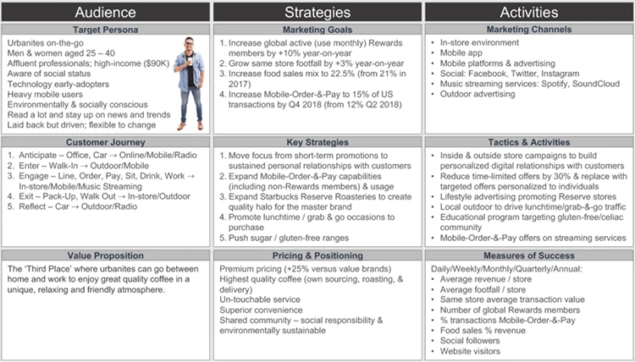
This comprehensive guide contains clear and easily organized categories, simple bullet points, and a straightforward one-page design that makes everything simple at first glance. There’s nothing that we can see missing from this marketing plan example, and it’s a great illustration of how you don’t need 79 pages of information to create an effective marketing plan.
A living document
Many businesses make the mistake of thinking their marketing plans and strategies should be one-off documents that don’t need to be altered. But this is wrong. Your strategy shouldn’t be completed and put in a draw. It should be constantly reviewed and revised to keep up with the needs of your business, changing customer appetites, etc.
While a business marketing plan and strategy will give you guidelines of where you should be and when, it cannot predict the future.
The best companies know that the only way to consistently attract new customers, create compelling blog content, or achieve any of your other marketing objectives is to treat plans like living documents… Updating as you go to ensure everything is always as fresh and relevant as possible. So, you can use your marketing plan to achieve your goals and take your business to the next level.

FAQ
How do you write a good marketing plan?
A good marketing plan will clearly define the who, what, where, why, when, and how of any promotional activities your brand will be undertaking in a given time frame. It should be viewed as a “living document” in that you must continuously review and alter (when necessary) to ensure your plan is always in line with your brand’s mission statement, values, and objectives.
What is a 5 point marketing plan?
You can build your plan based on the Five Ps of Marketing for a simplified marketing plan sample. These are Place, Price, Product, Promotion, and People. We also add Process and Physical evidence to this list to create a more comprehensive marketing plan that leaves no room for confusion.
How do you write a simple marketing plan?
To write a simple marketing plan, you can follow the eight steps outlined in the article above. These are:
- Confirm your mission statement
- Determine your goals and KPIs
- Identify your customer personas
- Dictate your content initiatives and proposed strategies
- Confirm anything you won’t be focusing on in your plan
- Specify a pricing strategy and budget
- Research the competition
- Establish roles
With this simple template, you’ll be able to create a high-quality new business marketing plan sample with ease.
What is in a marketing plan?
Simply put, a marketing plan acts as a roadmap for your marketing content, campaigns, and strategies. It will include everything your team needs to know about how their marketing efforts will relate to one another and the business as a whole and what targets need to be met.
A good marketing plan will clarify what everyone should be doing, what the business hopes to achieve, why specific channels are being used, who the target audience is, and much more.rnrn




